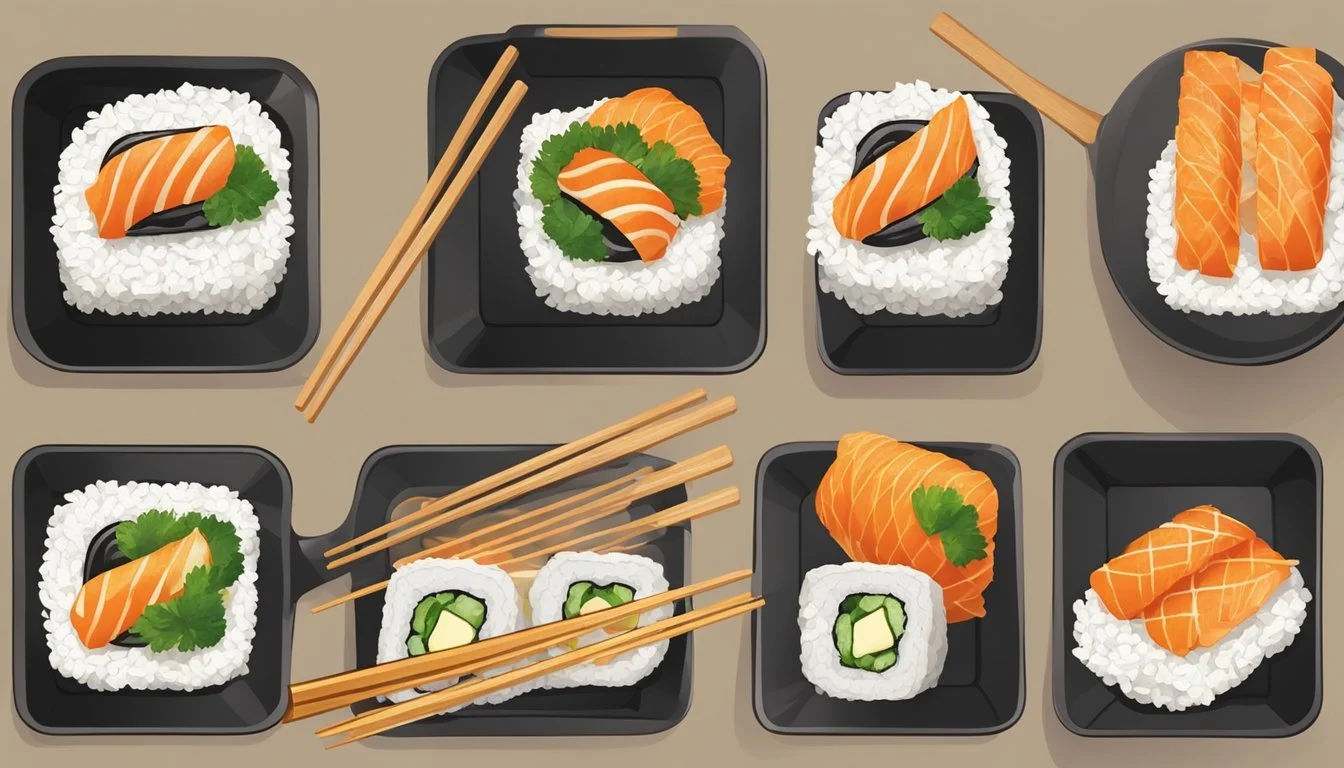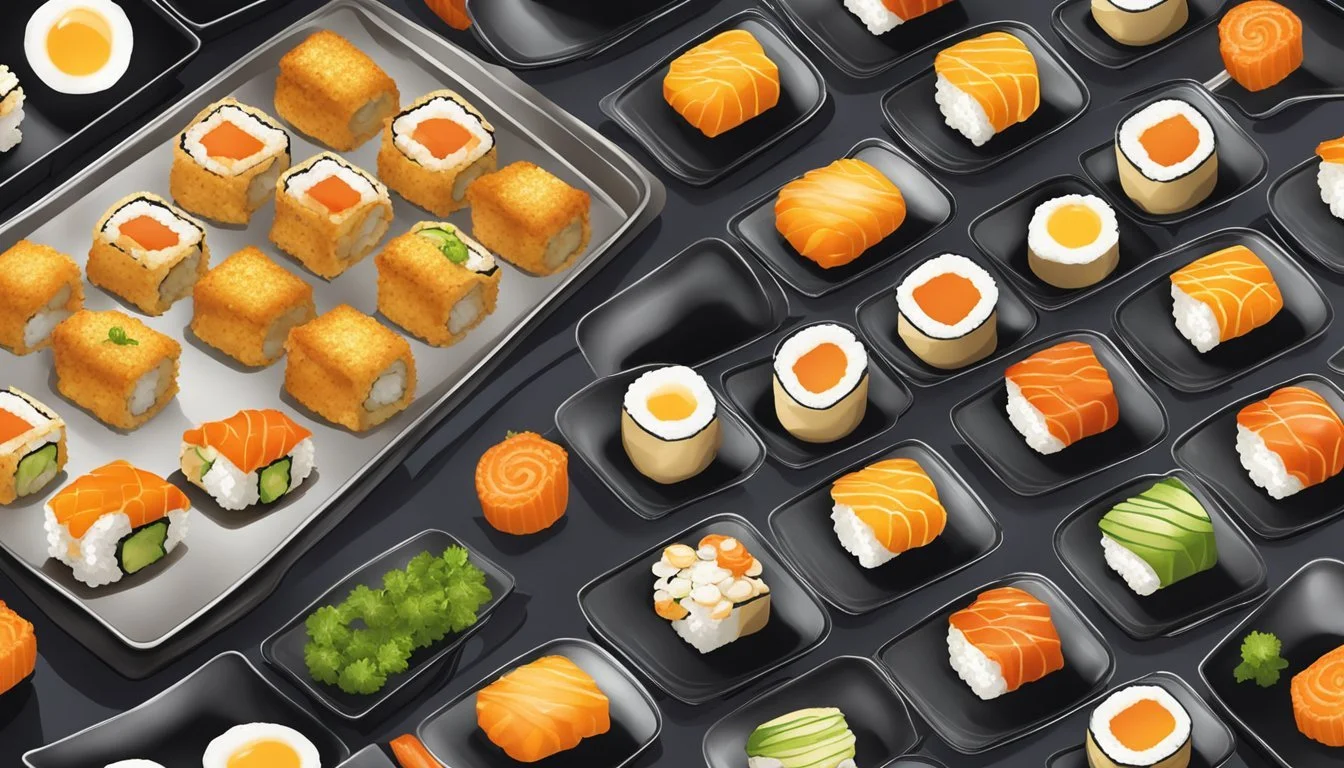The Pan-Fried Sushi Rolls
Achieving the Perfect Crunch without Deep Frying
Pan-fried sushi (What wine goes well with sushi?) rolls offer a distinctive twist on traditional sushi (What wine goes well with sushi?), providing a delightful crunch without the need for deep frying. This method transforms the sushi experience, incorporating texture and warmth while maintaining the essence of the fresh ingredients. As sushi lovers seek out healthier alternatives that still satisfy their cravings for crispy delights, pan-frying sushi rolls has become an innovative solution.
In this method, rolls are typically coated with a thin layer of panko breadcrumbs and then lightly fried in a skillet with just enough oil to crisp the exterior while preserving the integrity of the sushi rice and fillings. The rolls achieve a golden brown crust that contrasts with the tender interior, delivering a satisfying bite that deep-frying techniques often strive to create.
Pan-frying sushi does not merely alter its texture; it also introduces a new dimension of flavor. The gentle toasting of the outer layer adds a subtle nuttiness, enhancing the overall taste profile. This technique proves that enjoying crispy sushi does not have to mean indulging in the heaviness of deep-fried foods (What wine goes well with fried foods?), making pan-fried sushi rolls a popular choice for a lighter yet equally indulgent option.
Understanding Pan-Frying Techniques
Pan-frying sushi rolls involves specific steps and considerations to achieve a crispy exterior without the need for deep frying. Precision in heat management, choice of skillet, and use of oils play pivotal roles.
Essentials of Pan-Frying
One must ensure the sushi rolls are prepared with the ideal outer texture, which necessitates the use of suitable oils with a high smoke point, such as vegetable oil, to sustain the required temperature. A generous amount of oil allows for even cooking and crispness, without fully submerging the rolls. The oil should be heated to around 350°F (175°C) before the sushi rolls are introduced to the skillet.
Choosing the Right Skillet
A heavy-bottomed skillet is recommended for pan-frying as it distributes heat more evenly, preventing hot spots that could cause uneven cooking. Skillets made of cast iron or heavy-duty stainless steel are preferred choices. Size matters too—a skillet should offer enough surface area to cook the rolls without crowding, allowing each roll to contact the heat source directly.
Optimizing Heat Levels for Crispness
To achieve a crispy exterior without overcooking the interior, maintaining consistent heat is crucial. One should monitor the skillet's temperature, keeping it between 350°F to 360°F—a kitchen thermometer can assist in this task. The sushi rolls should be pan-fried for 2-3 minutes on each side, adjusting the flame as needed to maintain the temperature. After frying, sushi rolls benefit from being placed on a cooling rack or paper towels to remove excess oil.
Ingredients Breakdown
Creating the perfect pan-fried sushi roll hinges on a meticulous selection of ingredients that fuse traditional sushi elements with the satisfying crunch of a light pan-fry.
Selecting Quality Fillings and Proteins
For proteins, options can range from fresh salmon, tuna, crab meat, to shrimp. These should be sliced thinly to ensure even cooking and consistency within the roll. It is key to season the proteins lightly with salt and pepper to enhance their natural flavors.
Vegetables and Seasoning for Flavor
Incorporate a variety of vegetables such as avocado, cucumber, carrots, and sprouts for a crunch; mushrooms and cabbage can add depth. Season these vegetables with a blend of soy sauce, a pinch of sugar, and some fresh ginger and garlic for an aromatic touch.
Sushi Roll Staples: Rice and Wrappers
Sushi rice should be prepared with a careful balance of sugar and salt to attain the right level of seasoning and sticky consistency. For the outer layer, panko breadcrumbs provide a light, airy texture without the need for deep frying. Use a lumpia wrapper or nori sheet to hold the rice and fillings together. For an alternative take, vermicelli noodles can be crisped for an innovative wrapper that adds a new texture dimension to the roll.
The Cooking Process
Creating pan-fried sushi rolls merges traditional sushi making with a cooking technique that results in a crispy texture without the need for deep frying. This section outlines the steps for preparing sushi rolls, achieving the desired crispiness in a pan, and explores alternative methods using an air fryer and oven baking.
Preparing Sushi Rolls for Pan-Frying
Before pan-frying, the sushi rolls must be assembled with care. The chosen fillings should offer a combination of flavors that are both savory and tasty. It's important to roll the sushi tightly to prevent unraveling during the cooking process. To ensure they hold together and to add an extra layer of crispiness, sushi rolls can be lightly coated with panko breadcrumbs. This step is crucial for adding texture and maintaining the structural integrity of the roll when it hits the heat.
Achieving Crispiness Without Deep Frying
To achieve a crispy fried texture without submerging the sushi rolls in oil, one can use a frying pan for pan-frying. This method requires less oil and offers more control over the cooking process:
Pre-cook: Preheat the frying pan to a moderate temperature, around 350°F, which is hot enough to crisp the outer layer without overheating.
Oil: Add a small layer of oil, just enough to coat the bottom of the pan to prevent sticking while allowing the sushi roll to crisp.
Cooking time: Pan-fry the sushi rolls carefully, turning them to ensure even cooking and browning on all sides, typically for 2-3 minutes per side.
These steps help maintain the sushi roll's integrity while delivering a delightful crispy texture.
Alternative Cooking Methods: Air Fryer and Baking
For those seeking alternative cooking methods:
Air Fryer: Preheat the air fryer and cook the sushi rolls for around 3-4 minutes. The circulating hot air cooks the sushi evenly and results in a crispy exterior.
Baking: A conventional oven can also be used to create crispy sushi rolls. Bake the rolls at a high temperature (around 400°F) until they are golden and crisp, usually taking about 10-15 minutes.
Both methods are simpler and require less monitoring, making them ideal for those who prefer a hands-off approach to achieving a crisp sushi roll.
Serving and Presentation
When serving pan-fried sushi rolls, one must balance simplicity with elegance, emphasizing the crisp texture and complementary flavors. This section outlines the optimal ways to present and enhance pan-fried sushi rolls.
Accompaniments and Dipping Sauces
Serving Suggestions:
Pan-fried sushi rolls pair well with a variety of sauces and accompaniments that can elevate the dish.
Dipping Sauces:
Soy Sauce: It provides a salty umami flavor that complements the sushi's savory notes.
Sweet Chili Sauce: Offers a sweet heat that contrasts nicely with the rolls' crisp exterior.
Sriracha-Mayo: A creamy sauce with a kick, made by mixing sriracha sauce and mayonnaise, perfect for those who enjoy a spicy touch.
Oyster Sauce: Adds a deep, rich flavor, making it a suitable companion particularly for sushi with beef or pork.
Additional Condiments:
Wasabi Paste: Offers a sharp, pungent heat that should be used sparingly to accentuate the rolls without overwhelming.
Pickled Ginger: Known as sushi ginger, it serves as a palate cleanser between different types of sushi rolls.
Table Presentation:
Condiment Serving Style Soy Sauce Small individual dishes Chili Sauce Drizzled over the top or served on the side Sriracha-Mayo Dollop on the plate or in a small dish Oyster Sauce Drizzle or in a dipping dish Wasabi Paste Tiny mound on the plate's edge Sushi Ginger Neat pile on the plate or in a separate dish
Plating Techniques for Sushi Rolls
Plating Techniques:
Arrange rolls on a simple, elegant plate to emphasize their golden-brown hue against a clean backdrop.
Consider serving pan-fried sushi cuts standing up, showing off the cross-section and the crispy texture.
Use a brush to delicately apply sauces on the plate, crafting an artistic presentation that hints at the flavors to come.
Garnish with an herb or edible flower that contrasts the dominant colors of the dish, adding visual appeal.
Simplicity is key in plating; let the pan-fried sushi rolls be the star. The right accompaniments and sauces not only add to the flavor profile but also enrich the overall dining experience.
Health Considerations
When preparing pan-fried sushi rolls, one must consider both their nutritional content and how they can be adapted to suit gluten-free and vegan diets.
Nutritional Information
Pan-fried sushi rolls can vary in nutritional content depending on the fillings and preparation methods used. Typically, a sushi roll includes rice, fish, and vegetables, which provide a balance of carbohydrates, protein, and micronutrients. However, pan-frying sushi rolls introduces additional calories and fats. For instance, using a light pan-fry technique reduces the amount of oil absorbed compared to deep frying, which can significantly increase the caloric intake. It's also worth noting that traditional sushi accompaniments like soy sauce are high in sodium, which should be consumed in moderation.
Nutrient Consideration for Pan-Fried Sushi Calories Higher due to frying Fats Increased with oil used in frying Sodium Elevated if using soy sauce Protein Balanced when including fish Carbohydrates Predominantly from rice
Dietary Alternatives: Gluten-Free and Vegan
For those adhering to a gluten-free diet, one must be cautious as many ingredients commonly used in sushi, like soy sauce, contain gluten. Opting for tamari or a certified gluten-free soy sauce is a prudent choice.
In contrast, preparing a vegan variation of pan-fried sushi rolls requires replacing fish with plant-based proteins. Tofu, marinated and then lightly pan-fried, can serve as an excellent substitute. It is essential to ensure that all other ingredients, such as sauces and breading, are devoid of animal products to comply with vegan dietary requirements.
Gluten-Free Modifications:
Use gluten-free soy sauce or tamari.
Ensure all other ingredients, like tempura batter, are gluten-free.
Vegan Options:
Substitute fish with tofu or other plant proteins.
Verify that sauces and sushi rice (sometimes prepared with non-vegan additives) are vegan-friendly.
Storage and Reheating Tips
When storing pan-fried sushi rolls, it's crucial to keep them airtight to maintain their quality. They should be stored in the refrigerator and enjoyed within 1-2 days. For longer storage, one can opt to freeze the sushi rolls, although this may affect texture and taste upon thawing.
Refrigeration:
Wrap the sushi rolls tightly with cling film.
Place them in an airtight container to prevent the absorption of other food odors.
Consume within 24-48 hours for optimal freshness.
Freezing:
It's not generally recommended to freeze pan-fried sushi rolls due to the potential loss of texture.
If freezing is necessary, wrap each roll individually and store in a heavy-duty freezer bag.
Thaw in the refrigerator before reheating to ensure even warming.
Reheating:
Reheating should aim to revive the crispiness of pan-fried sushi rolls without drying them out.
Pan-frying: Heat a non-stick pan with a small amount of oil over medium heat. Place the rolls in the pan, turning occasionally until evenly warmed and crisp.
Skillet Method:
Heat a small amount of oil in a skillet over medium heat.
Cook for a few minutes on each side until heated through.
Using these methods, one can restore the warmth and texture of pan-fried sushi rolls efficiently. Remember that sushi is traditionally enjoyed at a temperature slightly below body temperature, so avoid overheating as it may deteriorate the quality of the rolls.
Frequently Asked Questions
Can I make crispy sushi rolls without a deep fryer?
Yes, one can pan-fry sushi rolls using a skillet with 1-2 inches of oil heated to 350-360 degrees Fahrenheit. Each side should be cooked for 2-3 minutes or until golden brown.
What kind of oil is best for frying sushi rolls in a pan?
It's recommended to use oils with a high smoke point, such as vegetable or canola oil, for frying to ensure safety and flavor.
How do you keep sushi rolls from falling apart when frying?
Ensure the sushi is rolled tightly. One may coat the sushi roll first in egg mixture (egg beaten with soy sauce and Sriracha), then in breadcrumbs to keep it intact.
What is the ideal temperature for frying sushi in a skillet?
The oil should be approximately 350 degrees Fahrenheit to ensure the sushi rolls fry to a golden brown without absorbing too much oil.
Do you need special equipment to pan-fry sushi rolls?
No special equipment is needed, just a skillet or a pan, oil, and standard kitchen utensils.
How do I achieve a crispy texture without overcooking the sushi?
Monitor each side carefully and cook for no longer than 2-3 minutes per side, ensuring that the heat is not too high to prevent burning.
Is it safe to eat fried sushi rolls the next day?
Fried sushi rolls can be safe to eat the next day if refrigerated properly. To restore crispiness, they can be reheated in an air fryer for a few minutes.
Can I reheat fried sushi rolls?
One can reheat fried sushi rolls in an air fryer or oven to bring back the crunch. The inside should be warm, and the outside crisp.









